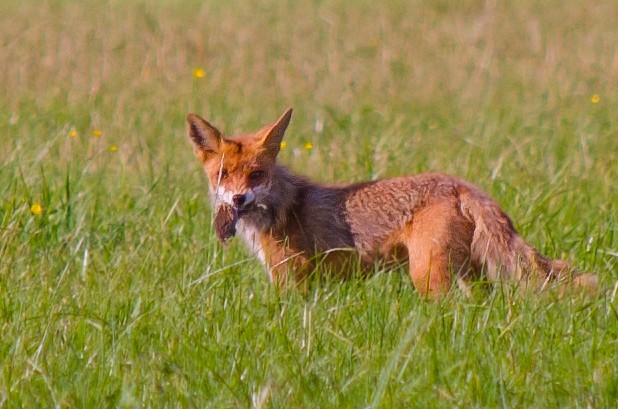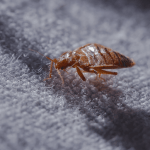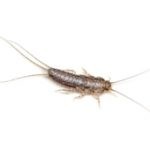Foxes UK

Image by: kuhnmi / License: CC BY 2.0
Foxes in the UK are a familiar sight in both rural and urban environments. While some view them as part of Britain’s wildlife heritage, others consider them troublesome pests. In this guide, we explore common problems associated with foxes, what attracts them, how destructive they can be, and effective ways to deter them.
The furry mammals, called foxes, are little to medium-sized beasties that have a mixed diet, eating everything from smaller animals to plants and eggs. Curiously, foxes are more similar to cats rather than dogs, so they love the nighttime and often live in underground dents, but this doesn’t imply that they don’t come out to raise a ruckus.
Types of Foxes in the UK
British Red fox (Vulpes vulpes crucigera)
Unlike their taller continental European cousins, British Red foxes are shorter but heavier creatures. Their fur usually has a rusty red hue with dark to black coloured legs, black pointy ears and a firm jaw with long canine teeth. Cute enough, their bellies and bottom of the neck have a bright white hue. A male fox is called a “dog” and a female, a “vixen.”
Vulpes entered British urban areas before the mid-90s, as many foxes went to the inner cities to search for better food supplies. Currently, according to the Mammal Research Unit at the University of Bristol, London is home to around 10,000 urban foxes. But we’ll discuss more on this later.
Foxes outside the UK
With over 37 types of foxes, researchers consider only 12 of those to be cousins of the British Red fox. Coming from the same gene, they live in several parts of the world, adapting to various climates; still, Red fox is the most commonly known. Also, each species of fox has an alternate name, but they all come from the same ancestors, even though they don’t have identical genes.
What Time Do Foxes Come Out at Night?
Foxes are nocturnal creatures, meaning they are most active during the night. Typically, foxes emerge after dusk, often between 8pm and 2am, depending on the season. In urban areas, foxes have adapted well to human activity and may be seen scavenging through bins, roaming gardens, or marking territory during these hours.
During breeding season, particularly between December and February, fox activity increases. You might hear the piercing screams of vixens (female foxes) or see them moving more boldly in residential areas.
What Attracts Foxes?
Foxes are omnivores and opportunistic feeders, often attracted by:
- Food waste in bins or compost heaps
- Pet food left outdoors
- Unsecured poultry or small livestock
- Overgrown gardens and sheds offering shelter
- Fallen fruits and bird feed
They are particularly drawn to easy sources of nutrition and quiet, undisturbed hiding spots to create dens. Gardens with dense shrubbery, open sheds, or spaces under decking are ideal fox shelters.
Are Foxes Destructive?
Yes, foxes can be highly destructive, especially in residential gardens and properties where they are not controlled. Common issues include:
- Digging holes in lawns to search for worms or create dens
- Tearing into bin bags, spreading rubbish across driveways
- Damaging fencing or enclosures to reach chickens or rabbits
- Marking territory with strong-smelling urine
- Chewing through cables or piping in sheds and outbuildings
Foxes are also known to scare pets, particularly smaller animals like cats, rabbits, and guinea pigs. While attacks are rare, their predatory instincts pose risks, especially if pet housing is not secure.
Foxes Diet
Foxes have an exciting eating routine. They are master trackers, getting hares, small and large birdies, rodents, frogs and worms, but the list doesn’t end here. Foxes are omnivores, meaning that they eat vegetables and fruits.
The urbanized foxes will likewise rummage for food in dustbins, making a mess when they see fit. They also frequently hunt for pigeons, mice and larger rats. Because foxes are creatures of the night, their hunting time is usually during the late hours, travelling significant distances looking for food.
Where Do Urban Foxes Live
Even though the total quantity of foxes living in the whole of the UK is unknown, the ones living in metropolitan regions are probably around 150,000 according to 2017 data. As we previously referenced, London alone is home to over 10 000 Vulpes.
As for the foxes’ homes, they create small underground sanctums to provide shelter when raising their offspring. In the cities, you can usually find those dens under small sheds, among tree roots, on railroad banks and in abandoned establishments. Foxes often find shelter in tunnels too, although they also love sunbathing when the weather is hot enough.
Here are some most common signs that a fox currently occupies a den:
- Leftovers of food, such as meat, vegetables and fruit
- Watch for fox poo close to their shelter
- Paw tracks and signs of recent activity near the den
- Unpleasant smells are uncommon in the city
Where Do Foxes Live in the UK
Most of the foxes in the UK live in the open country and woodlands, such as New Forest, the Forest of Dean, Sherwood, and others, however, as we recently referenced, the urban fox population is considered to be around 150,000.
Approximately 14% of foxes in the UK are living a city life and are becoming more and more acquainted with humans, with Bournemouth being the most fox populated city. London and Bristol have their share of Vulpes too. They usually prefer towns with smaller populations but are more and more seen wandering around the boroughs of Where Royalty Lives.
Are Foxes Considered Pests in the UK?
While foxes are not legally classified as vermin, they are regarded as pests when causing property damage or endangering animals. Local councils and pest control specialists are permitted to remove or deter foxes, provided all actions comply with UK wildlife protection laws. Shooting, poisoning, or inhumane trapping is strictly prohibited.
When Do Foxes Mate
Only once a year, the fox mating season starts in early January. Sometimes the loud mating cries can wake even the heaviest of sleepers right in the middle of the night, and we’ll dwell on fox noises further down the article.
Offspring that were brought into the world a year ago, presently young adult foxes, are considered a danger for the smaller cubs and often steal the food supplies. They also become competition for the mating male “dogs”. As harsh as it sounds, older pack members usually kick out young adults, who are lazy enough to stay for that long.
During the breeding period, foxes bring a litter of four to five whelps into the world. That takes place in mid to late March. The small cubs have to stay in their shelter for about two months, until the end of May, when they are big enough to follow in mom and dad’s footsteps. Vulpes leave their caves by the beginning of July, as the small ones learn more about the world.
What Do Foxes Do
Although foxes wander out during the day, they prefer the nighttime for hunting and scavenging. Those swift hunters have a remarkable ability to hear low-frequency sounds and use it as an advantage. They hear little underground creatures as they move, and are quick diggers, getting as close as possible, foxes rely on explosive jumps and well-thought moves to catch their prey.
Aside from using dens as breeding grounds, the foxes’ usually avoid staying for too long in their homes. When they sleep outside, Vulpes love using their fluffy tails as scarfs, warming their muzzles. Foxes are social animals and live in small families of three or four dogs and vixens.
Those cute creatures are benevolent and curious but are often terrified of humans. Foxes love playing games among themselves, just as with different animals. Some of their favourite playthings are balls and small toys, which they find in open lawns and gardens.
What Noise Do Foxes Make
You are probably wondering, what does the fox say? Well, not the strange sounds heard from that song that we’ve all heard.
In fact, foxes make a wide range of noises, such as barks, howls, screams, screeches and ‘gekkering’. There are considered being 12 distinct sounds delivered by grown-ups, compared to only eight by cubs. The ones that you can most often hear are screams and howls, and those can definitely make your hair stand up, especially during a calm night. Another spooky fox vocalization is their mating call – a short, piercing cry.
What Diseases Do Foxes Carry
Foxes are mammals, just like us, and in the same way they sometimes get sick or carry parasites and sicknesses which hypothetically can transfer to other animals. Luckily, there is not enough proof to establish an argument that Vulpes in urban areas in the UK are transmitting any diseases.
Curiously enough, you have a higher risk of catching a sickness from your pet dog or kitten, rather than a fox. Outside of the UK, however, there are two most diseases that foxes carry and transmit – rabies and alveolar echinococcosis, a parasitic sickness caused by fox tapeworm. With enough preventive measures, those two might never reach the British red fox population. So, you better book a professional fox control who will take care of the animal following all UK regulations.
How to Get Rid of Foxes in Your Garden
Those fluffy intruders can frequently be prominent and make a home or play area in your backyard or garden. Here are some tips on how to deter foxes easily, without hurting the creatures:
- Try not to take care of foxes – feeding them or sheltering them, even for a bit;
- Use solid concrete or stone bases for sheds, garages and fences, remember foxes love digging;
- Make sure your trash is in the right place, well-secured and hard to reach;
- Get rid of animal waste around your home and garden;
- The food scraps draw not only pigeons, mice and rats, but foxes as well;
- The smell of little pets can entice foxes, so secure your animals and provide them with adequate shelter, and if you suspect that a fox is in the vicinity, keep your pets inside;
Takeaways
The worldwide spreading of foxes, along with their far-reaching notoriety for their crafty nature, has added to their unmistakable presence in mainstream society and folktales throughout the world.
You can frequently find those omnivorous scroungers in urban city zones throughout the UK. The British red fox is a nocturnal mammal, implying that they prefer to hang out at night to chase prey.
As for the city foxes, they are exceptionally regional, covering significant distances in looking for food, regularly found in garbage bins and sheds. They can rarely come into your home, but if that happens, we suggest avoiding direct contact. Petting a wild fox can be dangerous for your health and the health of the creature.
Keep in mind that we only aim to provide some useful information about red foxes in general. We cannot guarantee that the pest in your garden you’re dealing with corresponds to the same description and are exactly the same.










